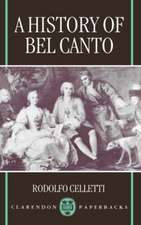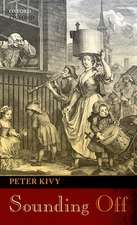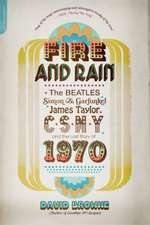The Sound of Nonsense: The Study of Sound
Autor Dr. Richard Elliotten Limba Engleză Paperback – 27 dec 2017
| Toate formatele și edițiile | Preț | Express |
|---|---|---|
| Paperback (1) | 157.32 lei 6-8 săpt. | |
| Bloomsbury Publishing – 27 dec 2017 | 157.32 lei 6-8 săpt. | |
| Hardback (1) | 464.45 lei 6-8 săpt. | |
| Bloomsbury Publishing – 27 dec 2017 | 464.45 lei 6-8 săpt. |
Preț: 157.32 lei
Preț vechi: 205.81 lei
-24% Nou
Puncte Express: 236
Preț estimativ în valută:
30.10€ • 31.43$ • 24.91£
30.10€ • 31.43$ • 24.91£
Carte tipărită la comandă
Livrare economică 04-18 aprilie
Preluare comenzi: 021 569.72.76
Specificații
ISBN-13: 9781501324543
ISBN-10: 1501324543
Pagini: 152
Dimensiuni: 140 x 216 mm
Greutate: 0.23 kg
Ediția:Paperback
Editura: Bloomsbury Publishing
Colecția Bloomsbury Academic
Seria The Study of Sound
Locul publicării:New York, United States
ISBN-10: 1501324543
Pagini: 152
Dimensiuni: 140 x 216 mm
Greutate: 0.23 kg
Ediția:Paperback
Editura: Bloomsbury Publishing
Colecția Bloomsbury Academic
Seria The Study of Sound
Locul publicării:New York, United States
Caracteristici
Argues for sound as a coherent thread to connect multiple examples of both 'high' and 'low' art-including nonsense literature, modernist/postmodernist/experimental writing, dada, sound poetry, tape art, comedy, jazz, pop music and sampling
Notă biografică
Richard Elliott is Senior Lecturer in Music at Newcastle University, UK.
Cuprins
Introduction1: The Sound of Nonsense2: The Sound of the Page3: Silly Noises4: Pop Hearts NonsenseConclusionBibliographyDiscographyVideography
Recenzii
Taking a literary and musical path - Lear and Carroll, literary modernism, translation, sonic art and pop records - Richard Elliott provides a sensible view of the nonsensical. Formed of much wordy noise, copious theory lightly handled, and palpable fondness in the writing, The Sound of Nonsense is a quietly provocative manifesto on nonsense's behalf.
Elliott's Sound of Nonsense is a deliciously noisy book, a lively sonic romp that enjoins its readers to be enjoyed aloud. It chants and enchants us through realms of utterance shaped by astonishingly diverse artists including Lewis Carroll and Hugo Ball, James Joyce and Bob Dylan, Velimir Khlebnikov and Jaap Blonk. Their often only just speakable tones and textures of proto-lexical sounds lure us into that zaum wonderland Paul Schmidt calls "beyonsense". Elliott's masterful, thoroughly useful scholarship is offset by his contagious delight in his subject. Echoes of poetry freed from semantic shackles, of scat, beatbox, and doowop, bounce off the page to activate our readership via the "mixing desk of the ear". This invigorating Sound of Nonsense makes sound sense.
There's no sense like nonsense, and here's a no-nonsense survey of it, from the simply silly to the profoundly pointed-a guide to the art of nonsense across cultural levels, at once scholarly and entertaining, original and enlightening.
Richard Elliott's The Sound of Nonsense is an exhilarating, well-informed, and very well written book. Elliott shows an easy familiarity with sources in many languages, including Russian. His principal theoretical assertion is that nonsense occurs in the moment "when sense-making is forced into code-switching;" he also offers the suggestion that nonsense as such supports sociality. Although the book appears to be principally about popular culture, it works closely with sound poetry and with recent experimental styles in modern vocal performance, revealing how they blend with the "popular" forms. It is a work that is rewarding not only for its ideas, but for its searching analysis of individual songs and unusual word-sound combinations. A satisfying book.
A cray and splendiferous example of how sound studies and its necessarily interdisciplinary modes of analysis will lead the way into new intellectual territory. Ranging widely from Lewis Carroll, Hugo Ball, and Gertrude Stein to John Cage, Bob Dylan, and Rahzel, The Sound of Nonsense is much more than a sonic intervention into nonsense scholarship, it is a bridge between music and literature that will open new lines of critical inquiry into the social life of words. Richard Elliott puts the ram in the rama lama ding dong.
Elliott's Sound of Nonsense is a deliciously noisy book, a lively sonic romp that enjoins its readers to be enjoyed aloud. It chants and enchants us through realms of utterance shaped by astonishingly diverse artists including Lewis Carroll and Hugo Ball, James Joyce and Bob Dylan, Velimir Khlebnikov and Jaap Blonk. Their often only just speakable tones and textures of proto-lexical sounds lure us into that zaum wonderland Paul Schmidt calls "beyonsense". Elliott's masterful, thoroughly useful scholarship is offset by his contagious delight in his subject. Echoes of poetry freed from semantic shackles, of scat, beatbox, and doowop, bounce off the page to activate our readership via the "mixing desk of the ear". This invigorating Sound of Nonsense makes sound sense.
There's no sense like nonsense, and here's a no-nonsense survey of it, from the simply silly to the profoundly pointed-a guide to the art of nonsense across cultural levels, at once scholarly and entertaining, original and enlightening.
Richard Elliott's The Sound of Nonsense is an exhilarating, well-informed, and very well written book. Elliott shows an easy familiarity with sources in many languages, including Russian. His principal theoretical assertion is that nonsense occurs in the moment "when sense-making is forced into code-switching;" he also offers the suggestion that nonsense as such supports sociality. Although the book appears to be principally about popular culture, it works closely with sound poetry and with recent experimental styles in modern vocal performance, revealing how they blend with the "popular" forms. It is a work that is rewarding not only for its ideas, but for its searching analysis of individual songs and unusual word-sound combinations. A satisfying book.
A cray and splendiferous example of how sound studies and its necessarily interdisciplinary modes of analysis will lead the way into new intellectual territory. Ranging widely from Lewis Carroll, Hugo Ball, and Gertrude Stein to John Cage, Bob Dylan, and Rahzel, The Sound of Nonsense is much more than a sonic intervention into nonsense scholarship, it is a bridge between music and literature that will open new lines of critical inquiry into the social life of words. Richard Elliott puts the ram in the rama lama ding dong.


















